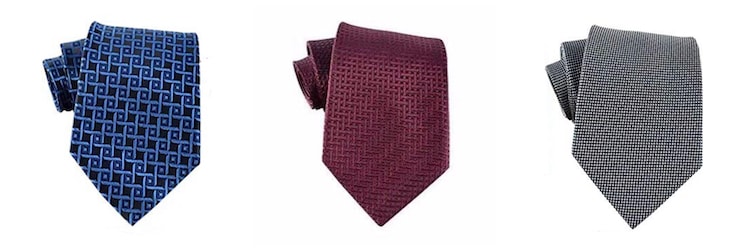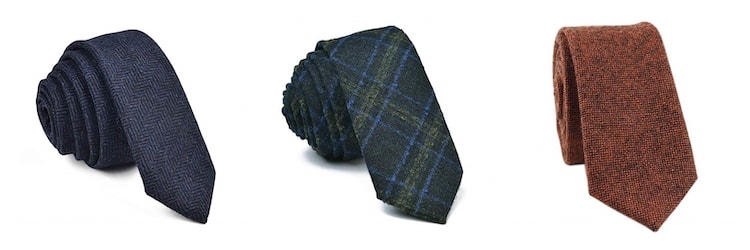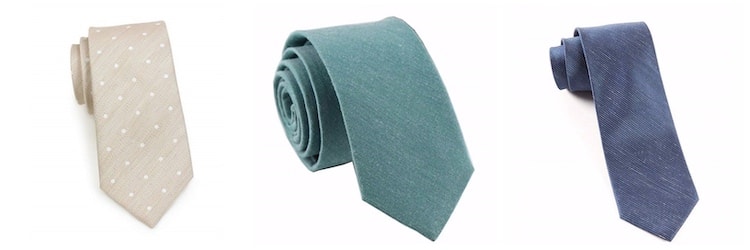- Home
- Style Advice Blog
- All You Need to Know About Ties: Part 2 - Tie Fabrics
Recent Posts
All You Need to Know About Ties: Part 2 - Tie Fabrics
Posted on
Ties come in all different kinds of styles and patterns, as you’ve seen in Part 1. Yet, not only are tie patterns different, so are the fabrics and materials that they’re made out of. The material of a tie affects its aesthetic look, feel and knot-tying qualities. Certain tie fabrics are more suitable for specific seasons, or for certain occasions. This guide will show you the features of the most common tie materials and when to wear which tie. Check out Part 3 for the various ways you can tie a tie.
Silk Ties

Silk ties are the most common type, for good reasons.
- Silk is luxuriously soft yet durable natural fabric. Its inherent elasticity enables it to withstand pulling. Thus, silk ties are fairly resistant to wrinkling and retain their shape well.
- Silk drapes well on the body.
- Silk keeps you cool on hot days and warm on cold days. It’s also highly absorbent, dries fast and lets the skin breathe.
How and when to wear silk ties:
- Silk ties are perfect all year round. As they can be both printed and woven, their variety is enormous and you can find one suitable for any business or social setting.
Polyester Ties
 Polyester is a silk look-alike and, thanks to modern technology, polyester and polyester-blend ties are able to mimic the same texture, feel and quality as silk, without the high price tag.
Polyester is a silk look-alike and, thanks to modern technology, polyester and polyester-blend ties are able to mimic the same texture, feel and quality as silk, without the high price tag.
- Polyester is wrinkle-resistant and easy to clean.
- With proper care, they can last a long time and retain their vibrancy.
- Polyester ties are generally the least expensive of ties because they’re primarily mass-produced in China
- Polyester is not breathable, which can make your neck hot and sweaty.
- Smells (e.g. from sweat) stay trapped and can’t be removed.
- Polyester ties have a stiffness that causes the knot to tend to slip.
How and when to wear polyester ties:
If you tend to get hot easily and sweat a lot, a polyester tie may not be for you. However, as they can be dyed and printed on easily, you can find a polyester or polyester-blend tie with a colour and pattern fit for any occasion. Considered cheap by some, you might like to swap a polyester tie for a silk one for important business meetings or formal events.
Wool Ties
Woolen ties are offer something a little more substantial and textured.
- Woolen ties are not “wooly”. They’re often made of suiting fabrics, and are all sophistication.
- Woolen ties are full-bodied and drape well.
- Knots tied with woolen ties are thicker, adding girth to your figure.
How and when to wear wool ties:
- Wear rough-surfaced woolen ties with rough-surfaced jackets, such as a tweed suit or jacket.
- Heavily textured woolen ties should be worn casually.
- Wear woolen ties during the cooler seasons. It can go with almost anything in your wardrobe, as long as it’s not worn with high sheen suits.
Linen Ties

The linen tie is the iconic summer tie. These ties are made from the fibres of the flax plant.
- Linen is the strongest natural fiber, meaning linen ties last a very long time.
- Linen ties are well-suited to hotter weather as they are lightweight and breathable.
- As linen creases easily, look for linen ties with proper lining.
- Linen ties have an attractive lustre and supple feel, thanks to linen’s natural wax content.
How and when to wear linen ties:
- Though crisper than cotton, linen ties exude a relaxed vibe, and as such should be worn on casual occasions.
- Linen ties are excellent at adding textural variation to standard woolen suits.
Cotton Ties
Both made from plant fibres, cotton and linen ties tend to look quite similar, though pure cotton ties are less common.
- Cotton ties are soft and breathable
- Cotton ties resist wrinkling and resist fading. This is tie you could machine wash!
How and when to wear linen ties:
- Like the linen tie, cotton ties are best suited for summer and laid-back social events.
- Cotton (or linen) ties are great mixed with a variety of textures and patterns, such as a linen or hopsack suit.
Knit Ties

Knit ties are characterised by a highly textured, open-weave appearance and flat, squared bottom. They come in both silk and wool varieties, which means that you can wear them in summer as well as in winter.
- The knitted fabric adds texture and subtle pizzazz to any outfit.
How and when to wear knit ties:
- If you’re just starting out with your first few knitted ties, begin with solid colours. In winter try deep shades such as navy, burgundy or brown, and in summer go for lighter, pastel colours. They’re versatile and you’ll wear them many times.
- Knitted ties worn with a crisp white shirt is a polished and powerful look.
- Knitted ties are on the less formal side, so use them to dress up a casual outfit or dress down a suit.
Knowing the differences between tie materials and fabrics will make it easier to choose a tie next time you're shopping for one. If you’ve seen our previous blog post on tie patterns, then you're now much better equipped to build a stylish and practical tie collection. To complete your dapper look, why not pair it with a suit as unique as your tie? Book a fitting at Joe Button today.
 Loading... Please wait...
Loading... Please wait...

